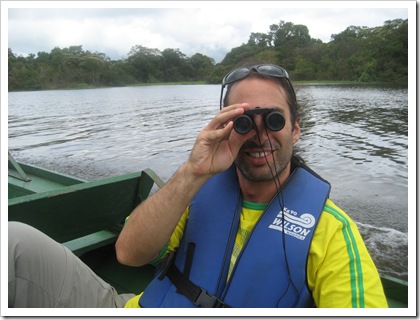
To find out, we would have to take daily canoe trips into the forest. This required a lot of preparation. First of all, mosquito repellant must be applied to all parts of the body. But not your garden variety repellant. It must contain a not so healthy portion of 'Deet' which does an almost fantastic job of keep the bloodsuckers away. Because Deet is not fool proof, you also need to be clothed from head to toe (something Jez is not accustomed to).
We found out the hard way that the mosquitoes here are so aggressive, they bite straight through clothes! So despite being fully clothed and heavily coated with Deet we still got bitten. But note how our guide's idea of protective gear involved wearing just t-shirt, shorts and thongs...
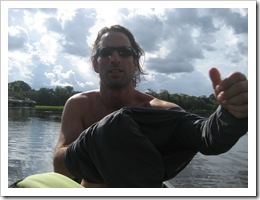
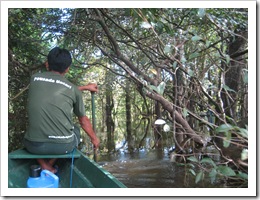
Mamiraua is special for another reason. It is endemic to an exotic and endangered monkey called the White Uakari. As its name suggests it is white with very long fur and a bright red face. The locals nicknamed the monkey 'Englishman' for obvious reason but the bright red face, although quite similar to a sun burnt Pom really does look more similar to a baboons butt.
Anyway, they used to be captured and sold or killed for meat. This no longer happens but it seems that the uakari has not forgotten its checkered past. They are incredibly difficult to spot and are very shy.
So before entering the forest by canoe, we had to take a vow of silence (something TZ is not accustomed to) so as not to scare them or the other wildlife away.
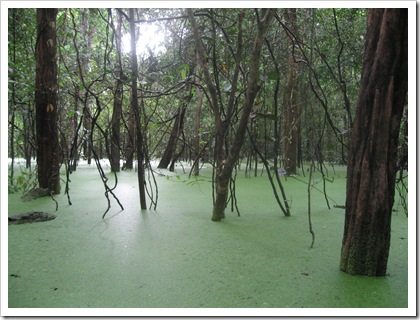
We were quite sure our guide had x-ray vision because when he stopped the canoe and pointed up into the tree mouthing uakari we could see jack sh..
We squinted and craned our necks, took hundreds of photos of little blurry moving red and white dots up in the canopies but in the end it was hard to claim we actually SAW anything.
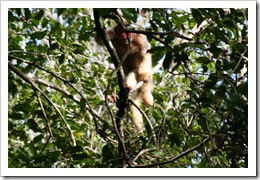
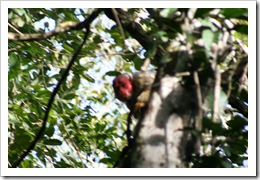
The ring tailed coati on the other hand is easier to spot. They are noisy and travel in packs.

Our home for the next few days would be a floating lodge. In the drier season the lodge is on the edge of a lake, but in the wet season it becomes an island accessible only by boat. The lodges can hold up to 20 people but we were incredibly lucky as when we arrived there was only one other couple. It felt like we had all one million hectares of Mamiraua to ourselves!

Naturally indemnity forms had to filled out but we signed without hesitation as we felt pretty confident we were in safe hands...

Except for the day when TZ stepped out of her bedroom and made her way to reception. On return she saw this caiman sunning itself up on the patio blocking her path back to her room!

Thankfully there was no noise ban in the lodge. Click below to find out what happened next...
Although it was the rainy season, it was still incredibly hot and sticky. We had a pool next to our lodge which we had considered safe until we saw how agile the caiman was. Nevertheless, we were concerned that we would not have enough material for the blog and so Jez bravely and gingerly took a dip.
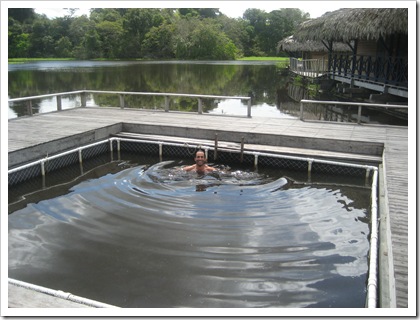
At dinner that night, we asked if the resident caimans had ever attacked a guest. Only once we were told. A Japanese girl decided to lean right over the edge of the river to take a photo of one. Startled, the caiman leapt out of the water and head butted the girl in her stomach, pushing her over.
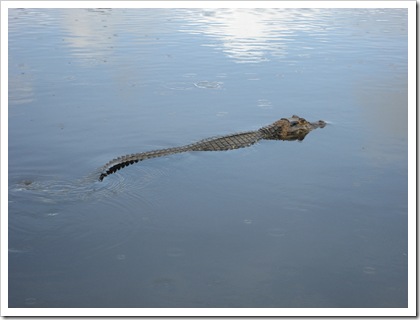
Each morning we would wake up to a cacophony of sounds from the forest on our doorstep. The most prominent of all was the growl of the howler monkey. They have a big bone at the back of their tongue and when air passes over it, the sound effect is similar to blowing over the opening of a bottle...except it comes out very powerful and very deep.
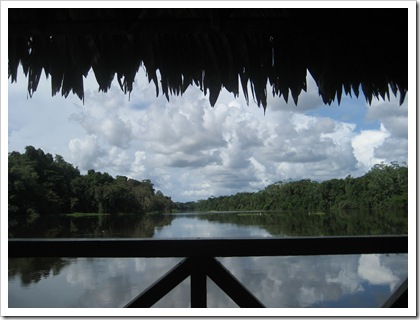
Curious to see these guys we spent many hours in the canoe trying to track them down. Again we had to be extra quiet. Not so much because we didn't want to scare them away but because when frightened, they release a hideous spray of dung and urine.
Click below to see a video of us silently tracking these noisy creatures. Make sure you have your volume up so you can hear the Howlers at work.
I wish we could say this we took this photo a howler monkey. Thank you to John and Finola for sending this one to us!
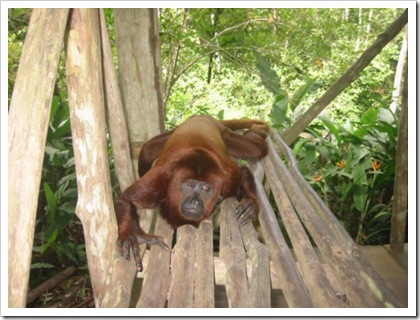
Every day our guide would point out one or two sloths. Experts at camouflaging themselves, we found it near impossible to see them even if they weren't high up in the canopy. Sloths are solitary creatures and they move so slowly every movement they do looks like an act of Tai Chi. Even their digestive system is slow, it takes 25 hours just to digest their breakfast! The only time they really move is during their once-a-week visit the "toilet tree".
This variety is called the brown-throated three-toed sloth. These photos are courtesy of our Belgian friend with his kick-arse camera.
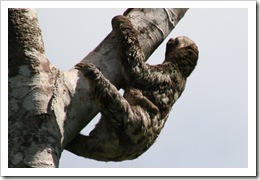
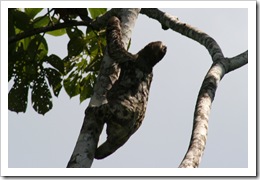
One evening, our guide canoed us out into the forest so we could see what it was like to spend the night in the Amazon. We all slept in hammocks in this bird house, beside the 'jaguar tree'.
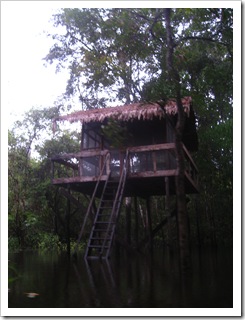
We wished our guide spoke English or at least Spanish so he could tell us ghost stories but he didn't so we fell asleep to the sounds of the forest. Here is a little video we made when we farewelled our canoe and climbed up the stairs...
This was not our only adventure into the forest at night. We were keen to see some anacondas and tarantulas and this required a night mission. The mosquitoes are even more ferocious at night - or so it seemed - and we decided to up the level of protection to head nets and wet weather gear...
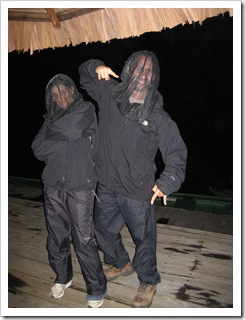
Back in the canoe, we took our vows of silence and headed back into the dark forest. To break the suspense, we did not see any anacondas. To add to the suspense, while waiting to find out what was around the next tree, a sardine jumped into the canoe and landed between TZ's legs. Shrieks and canoe rocking ensued and just when the sardine had been safely returned to the water, a giant tarantula appeared on a tree next to us. Jez had little luck trying to convince TZ that it would not jump from the tree into the canoe...
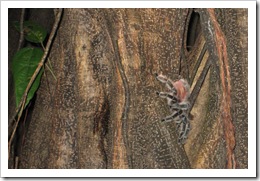
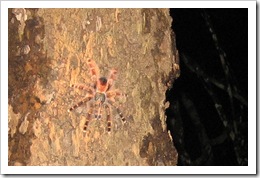
Speaking of spiders, the following pictures demonstrate the difference between a monkey spider, and a spider monkey.
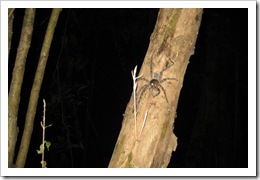
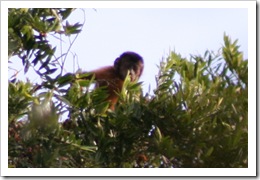
At night, it is easy to spot caimans as their eyes shine bright yellow in the dark. So even though this baby was hiding under the leaves we could still see him.
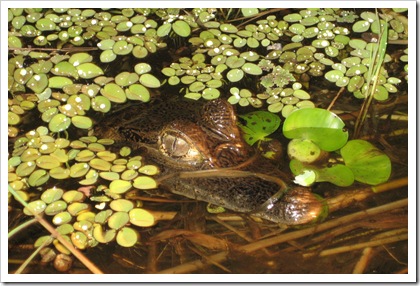
We gave our necks a rest from looking up into the trees to focus on what was in the water. Naturally, we were very curious about the piranha. We had two important questions. One: Were they really as dangerous as they are made out in the movies and two: Were they kosher to eat? The second was necessary to know because we were going to catch one for lunch. We had tried to research this weeks before back in Salvador where we met a rabbi. His answer was "well, if it has scales and fins then yes, it is kosher." However, none of us had seen a piranha that close up so we were still in the dark. The rabbi then called another rabbi who lives in Belem, on the mouth of the Amazon. His answer was "well, if it has scales and fins then yes, it is kosher."
To solve the mystery we would need to take a close look at the fish. To catch a piranha is not an exact science. Basically, you need a long stick, some fish wire and a bit of dead fish for bait. The rod is cast into the river. The bait is tapped into the water and within seconds, or minutes if you are unlucky, a piranha will bite. Watch to see Jez complete the task:
Now that we were able to see the fish close up we could confirm that it was indeed kosher!
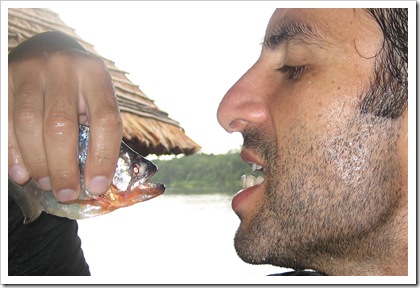
With a set of teeth like these we had no doubt about its biting capabilities.
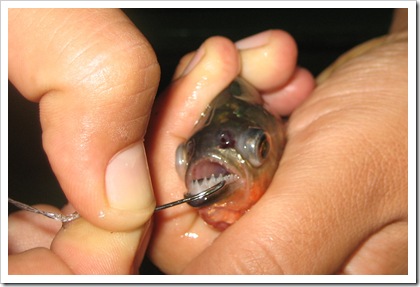
Legend has it that should a single woman in one of the communities in Mamiraua suddenly find herself pregnant, it is because the boto paid her a visit. The boto is a pink dolphin found in the Amazon. Apparently he appears at parties dressed in a white suit and top hat and lures young girls to bed. This the locals know for certain. What they don't know is why the dolphin is pink. No one knows for sure but it could be that their blood vessels are very close the surface. That said, when we got our one half-decent photo, we thought pink was a description used very loosely...

The botos are actually a very interesting example of evolution. Originally the pink dolphin lived in the Pacific Ocean. When the Andes rose, some of them were trapped in the rivers of the Amazon. Their new environment meant they would have to manoeuvre around narrow passages between trees, dodge branches and eat fish they were not accustomed to. To do this they would need to change physiologically. And change they did.
The vertebrae in the necks of marine dolphins are fused, to provide the strength required for aerial acrobatics. Botos however can freely move their necks, enabling them to navigate through the flooded forest. Unfortunately this means they cannot leap out of the water like their cousins making it very hard for us to photograph them! They can also reverse thanks to their new fins which can flap backwards, handy for if they are trying to abort a mission into a knot of branches.
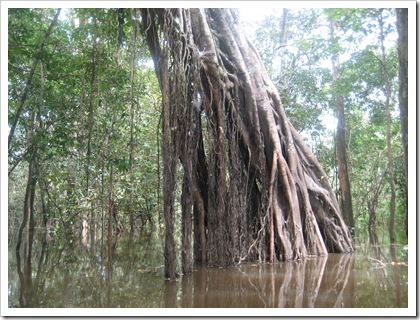
There were several animals we were very sorry we didn't see. The jaguar was one of them. Although we did actually spend the night in a birdhouse opposite a tree known to be frequented by jaguars, we never saw one. This is because no one actually knows where jaguars disappear to in the wet season. We know they can climb trees so we could expect to see one up a trunk but no one ever has. A special tracking program is being put into place to solve the mystery but in some ways, it is nicer not to know.
Unfortunately, the only ones we did see were back at the zoo in Manaus. They seemed very unhappy pacing around and making a lot of sad sounding noises but so you can see what a magnificent creature the jaguar is we have included this photo.
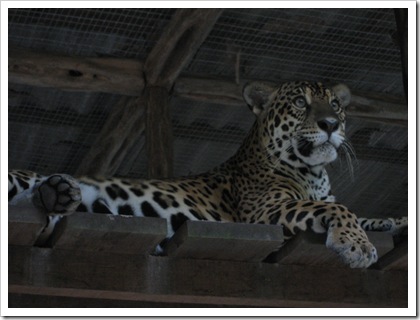
When we weren't canoeing out into the forest searching for animals, we spent some time learning about the communities in Mamiraua. The people that we met are not the traditional land owners. They are not people-eating, voodoo-practicing Indians like one might see in the movies. Those communities have strict laws preventing outsiders from visiting. So the people we did meet were the result of a mixture of Indian, Negroes and European stock who have been living in the reserve for the last 60 years or so. Here you can see one of their houses - complete with satellite TV.
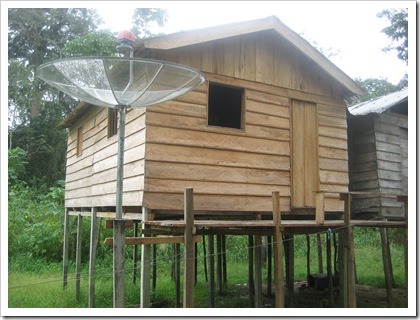
We also got to see their school. The textbooks teach them about the animals in the Amazon, how to fish, how to make manioc (a root vegetable) and basic survival skills should they find themselves lost in the forest at night.
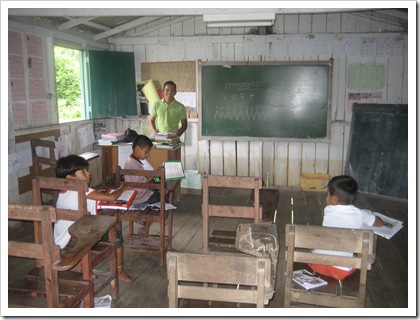
Our guide was keen to put a show on for us in his house. His band of three sang songs about Mamiraua and the legends of the Amazon. Over 3 months later, we still have the Mamiraua song stuck in our head. Listen at your own peril...
One evening we were invited to a religious festival at another community. They were celebrating the Holy Ghost in a most unusual way. Twin poles covered in green bananas were erected and and fireworks exploded. In 7 days time, when the bananas would be ripe enough to eat, another ceremony would take place.
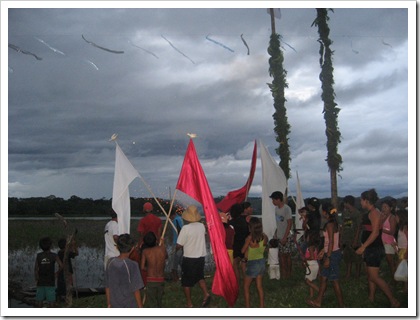
After the poles were erected, this strange soup was passed around.
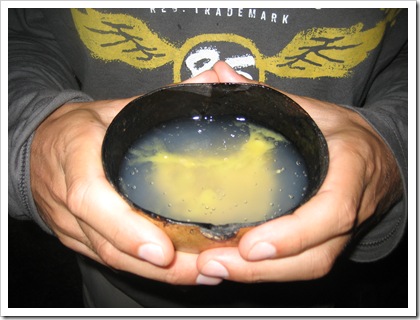
To spice it up a little, a scary-looking chili was offered and Jez was the only one brave enough to devour it whole.
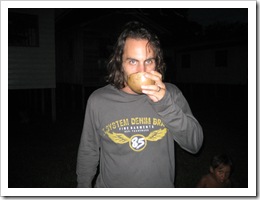

After 'entree' we were invited back to the family of our guide for dinner. Our meal was prepared by candlelight and we sat on the floor in the kitchen.

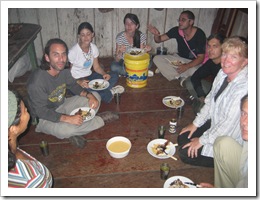
In the wee hours of the following night, Jez woke up feeling rather nauseous. This was the night we slept in the bird house. When we woke up, Jez gesticulated wildly to our guide indicated he was feeling very ill and wanted to go straight home. Back at the floating lodge Jez was a rather pale shade of green. We were due to leave that day but wisely decided to postpone our stay for another few days. Luckily our over-sized medical kit came in good use and Jez was back in business after 24 hours. His stomach however had shrunk and the toilet was a no-go zone.
We spent the afternoons relaxing in our dual hammocks chatting to Dave, our American neighbour on the porch next door.
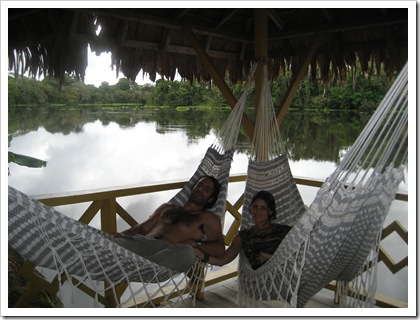
When we looked up at the eves of our porch we noticed a merry band of bats. It was nice to know some animals were easy to spot without binoculars!
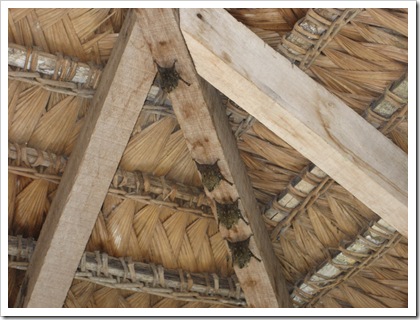
To the left is our lovely guide who taught us everything we known about Mamiraua reserve, the wildlife and the communities who live here. To the right is our amazing canoe guide who skilfully and silently led our canoe expeditions, slept in the birdhouse with us and released the rest of the piranhas we caught but never ate.
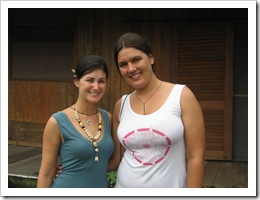
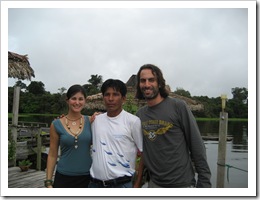

No comments:
Post a Comment